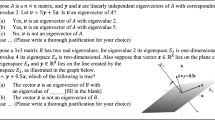Abstract
Many studies provide insights into students’ conceptions of various linear algebra topics and difficulties they face with multiple modes of thinking needed for conceptualization. While it is important to understand students’ initial conceptions, students’ transfer of learning of these conceptions to subsequent courses can provide additional information to structure meaningful curricular materials. This study explores physics students’ transfer of learning of eigenvalues and eigenvectors from prerequisite experiences to quantum mechanics. Data analysis focused on three task-based interviews with undergraduate students, observations of physics courses, and students’ course artifacts. Existing studies on students’ conceptions of linear algebra topics indicate the necessity of developing flexible shifts between different modes of thinking in order to grasp linear algebra. This study’s participants, who had initial learning experiences of linear algebra, were also observed to struggle with such shifts prior to quantum courses. It seems that various contexts in quantum courses, and explicit instructional methods, provided opportunities for students to enhance this initial learning of eigenvalues and eigenvectors. In particular, the explicit reasoning of one of the quantum courses’ instructors concerning the choice of certain representations during problem solving in class, seemed to facilitate students’ construction of similarities, thus providing evidence for actor-oriented transfer. Results of this study align with goals for recently developed instructional materials and interventions that emphasize opportunities for students to inquire and connect multiple modes of thinking.

Similar content being viewed by others
References
Auerbach, C., & Silverstein, L. B. (2003). Qualitative data: An introduction to coding and analysis. New York: NYU Press.
Bransford, J. D., Brown, A. L., & Cocking, R. R. (1999). Learning and transfer. In J. D. Bransford, A. L. Brown, & R. R. Cocking (Eds.), How people learn: Brain, mind experience, and school (pp. 51–78). Washington, DC: National Academy Press.
Conference Board of the Mathematical Sciences (CBMS) (2016). Active learning in post-secondary education. http://www.cbmsweb.org/Statements/Active_Learning_Statement.pdf. Accessed 3 Mar 2019.
Dorier, J.-L., & Sierpinska, A. (2001). Research into the teaching and learning of linear algebra. In D. Holton (Ed.), The teaching and learning of mathematics at university level: An ICMI study (pp. 255–273). Dordrecht: Kluwer Academic Publishers.
Karakok, G. (2009). Students’ transfer of learning of eigenvalues and eigenvectors: Implementation of Actor-Oriented Transfer framework. Doctoral dissertation, Oregon State University, 2009, Corvallis, OR.
Larson, C., & Zandieh, M. (2013). Three interpretations of the matrix equation Ax = b. For the Learning of Mathematics,33(2), 11–17.
Lester, S. (1999). An introduction to phenomenological research. Taunton: Stan Lester Developments.
Lobato, J. (2003). How design experiments can inform rethinking of transfer and vice versa. Educational Researcher,32(1), 17–20.
Lobato, J., & Siebert, D. (2002). Quantitative reasoning in a reconceived view of transfer. Journal of Mathematical Behavior,21, 87–116.
Mestre, J. (2003). Transfer of learning: Issues and research agenda. http://www.nsf.gov/pubs/2003/nsf03212/. Accessed 2 Nov 2005.
Patton, M. Q. (2002). Qualitative research and evaluation methods. Thousand Oaks: Sage Publications.
Sierpinska, A. (2000). On some aspects of students’ thinking in linear algebra. In J. L. Dorier (Ed.), On the teaching of linear algebra (pp. 209–246). Dordrecht: Springer.
Stewart, S., Andrews-Larson, C., Berman, A., & Zandieh, M. (Eds.). (2018). Challenges and strategies in teaching linear algebra. https://doi.org/10.1007/978-3-319-66811-6.
Stewart, S., & Thomas, M. (2009). A framework for mathematical thinking: the case of linear algebra. International Journal of Mathematical Education in Science and Technology,40(7), 951–961.
Stewart, S., & Thomas, M. O. J. (2010). Student learning of basis, span and linear independence in linear algebra. International Journal of Mathematical Education in Science and Technology,41(2), 173–188.
Thomas, M. O. J., & Stewart, S. (2011). Eigenvalues and eigenvectors: Embodied, symbolic and formal thinking. Mathematics Education Research Journal,23, 275–296.
Thompson, C. A., Stewart, S., & Mason, B. (2016). Physics: Bridging the embodied and symbolic worlds of mathematical thinking. In T. Fukawa-Connolly, N. Engelke Infante, M. Wawro & S. Brown (Eds.), Proceedings of the 19th Annual Conference on Research in Undergraduate Mathematics Education (pp. 1340–1347). Pittsburgh, Pennsylvania.
Wawro, M., Watson, K., & Christensen, W. (2017). Meta-representational competence with linear algebra in quantum mechanics. In A. Weinberg, C. Rasmussen, J. Rabin, M. Wawro, and S. Brown (Eds.), Proceedings of the 20th Annual Conference on Research in Undergraduate Mathematics Education (pp. 326–337), San Diego, CA.
Wawro, M., Zandieh, M., Sweeney, G., Larson, C., & Rasmussen, C. (2011). Using the emergent model heuristic to describe the evolution of student reasoning regarding span and linear independence. In Paper presented at the 14th Annual Conference on Research in Undergraduate Mathematics Education, Portland, OR.
Zandieh, M., Wawro, M., & Rasmussen, C. (2017). An example of inquiry in linear algebra: The roles of symbolizing and brokering. PRIMUS,27(1), 96–124.
Author information
Authors and Affiliations
Corresponding author
Additional information
Publisher's Note
Springer Nature remains neutral with regard to jurisdictional claims in published maps and institutional affiliations.
Rights and permissions
About this article
Cite this article
Karakok, G. Making connections among representations of eigenvector: what sort of a beast is it?. ZDM Mathematics Education 51, 1141–1152 (2019). https://doi.org/10.1007/s11858-019-01061-9
Accepted:
Published:
Issue Date:
DOI: https://doi.org/10.1007/s11858-019-01061-9




